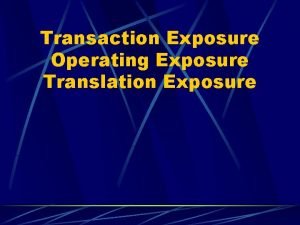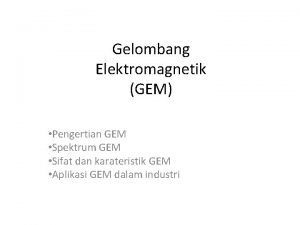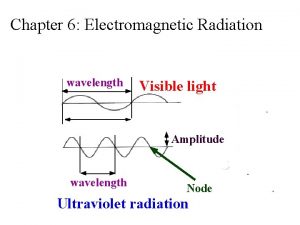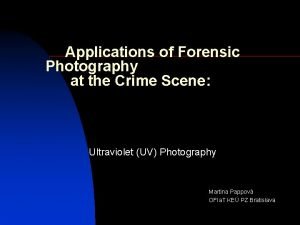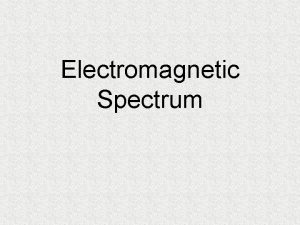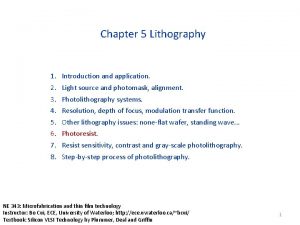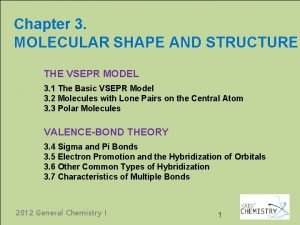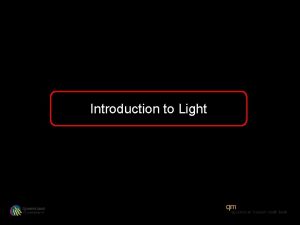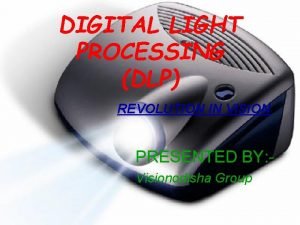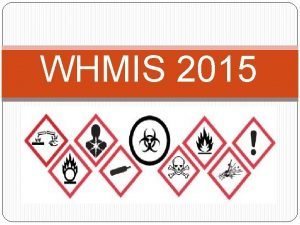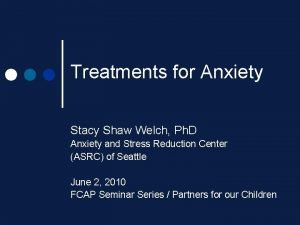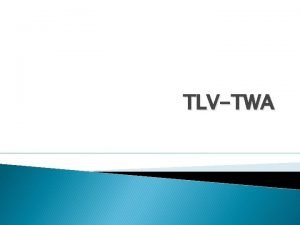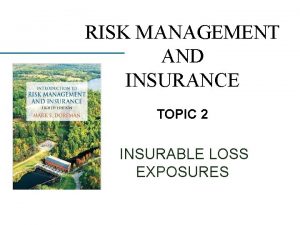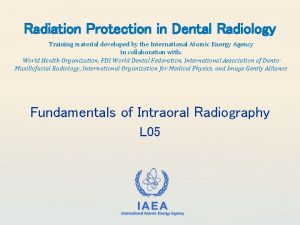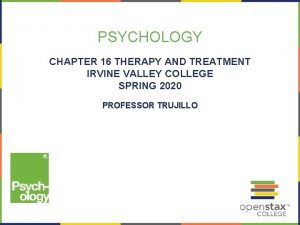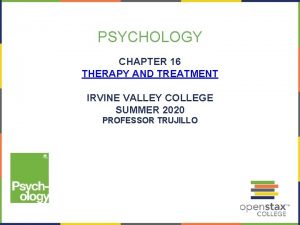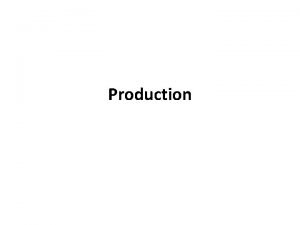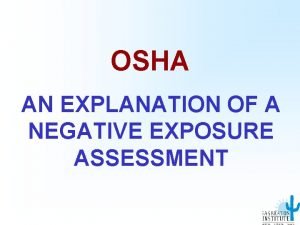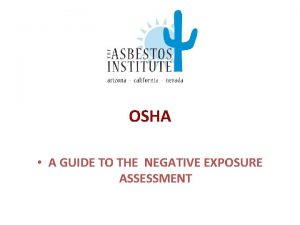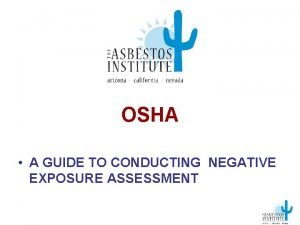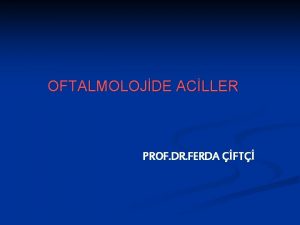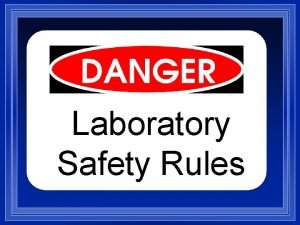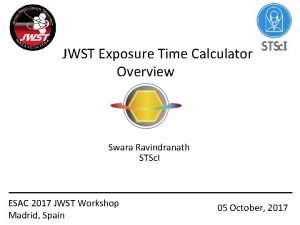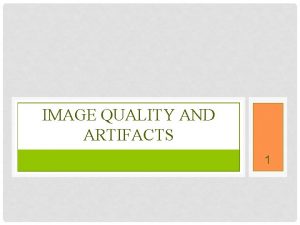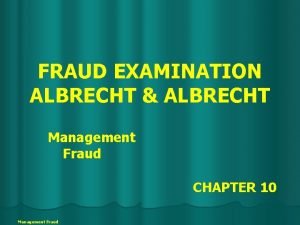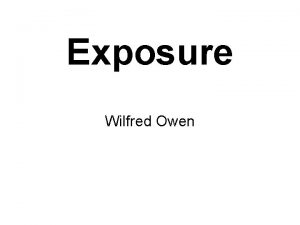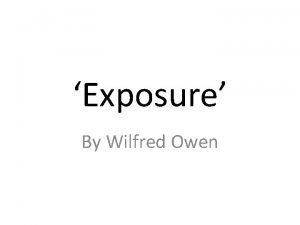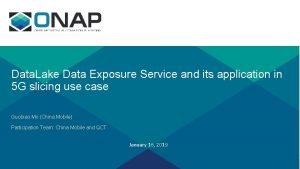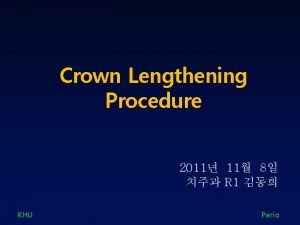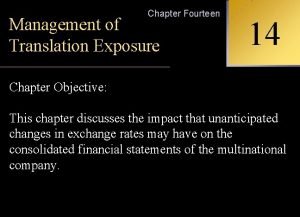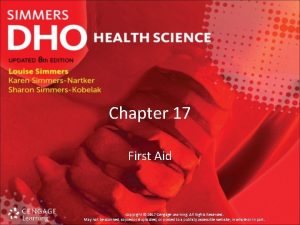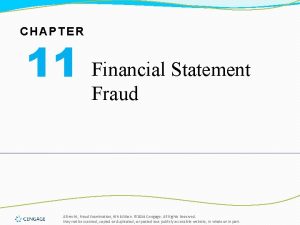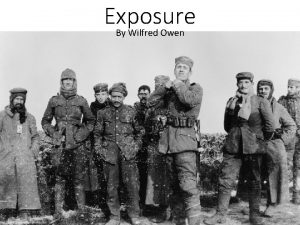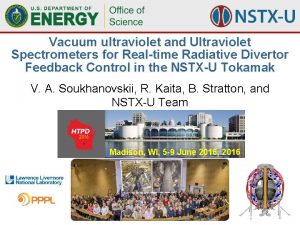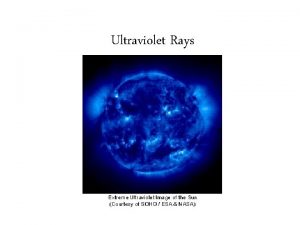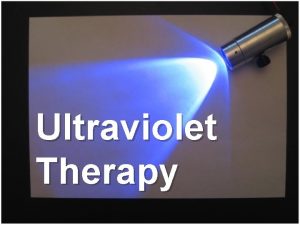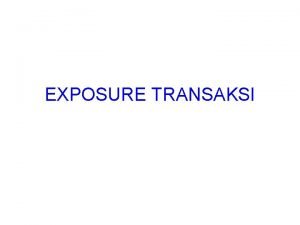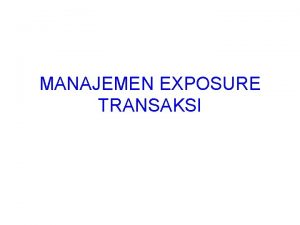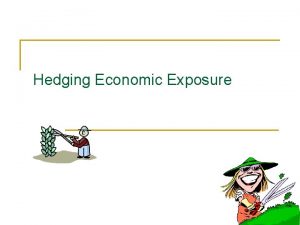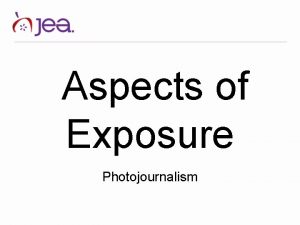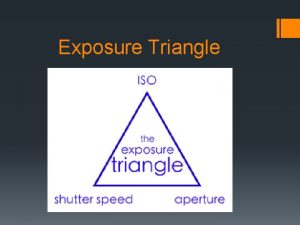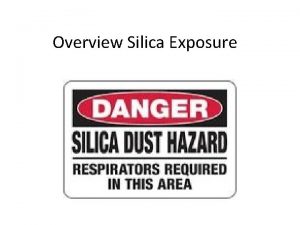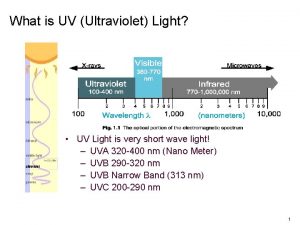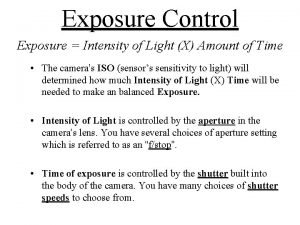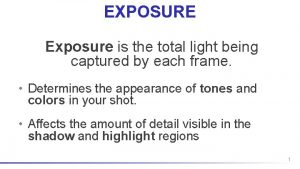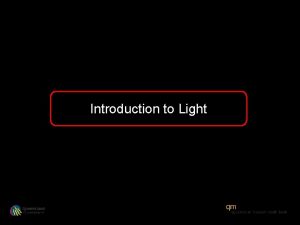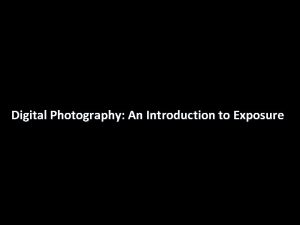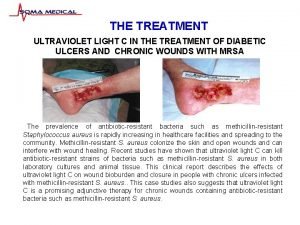EXPOSURE TO ULTRAVIOLET UV LIGHT An Introduction To


























































- Slides: 58

EXPOSURE TO ULTRAVIOLET (UV) LIGHT An Introduction To The Health Effects of Radiation Elena Fridman Beilinson Medical Center Tel Aviv University Israel

ULTRAVIOLET RADIATION | Most significant source of U. V. is the sun. | 1801, Johann Wilhelm Ritter | Electromagnetic radiation | Wavelength 400 nm to below 290 nm. | Divided into three bands, A, B and C band.

| A and B bands reach the earth, whereas C band is filtered by the ozone layer. U. V. A penetrate farthest | Produce physiological effect by non thermal mechanism | Deepest penetration with high intensity, long wavelength and lower frequency.

1. Ultraviolet C (UVC, 100 -290 nm) are the shortest and most energetic portion of the UV spectrum. These highly energetic wavelengths The important wavelengths in the UVC are removed within the atmosphere, mainly by absorption in the ozone layer and not reach the earth's surface in any quantity. 2. Ultraviolet B (UVB, 290 -320 nm) is the most damaging part of UVR that we encounter. UVB are wavelengths mostly blocked by dense clouds, closely woven clothing and glass window panes. Significant amounts are transmitted from blue sky in the middle of the day in summer. It is less dangerous when the sun is low in the sky, at high latitude in winter, and in early mornings and late evenings in summer. 3. Ultraviolet A (UVA, 320 -400 nm) is about 1000 times less damaging to the skin than UVB as measured by sunburn (Erythema) or damage to cell DNA. On the other hand, 20 times more UVA than UVB reaches the earth in the middle of a summer's day. It is not greatly affected by absorption and scattering in the atmosphere when the sun is low in the sky, and is now known to contribute significantly to the total exposure at moderate levels throughout the whole day and year. UVA penetrates deeper into the skin and leads to deeper damage than UVB does. It penetrates cloud cover, light clothing and untinted glass relatively easily, and may induce a degree of continuing skin damage over long periods, even when UVR exposure is not obvious. American Cancer Society 2006

PHYSIOLOGICAL EFFECTS OF U. V. R 1 - Erythema production: Generalized response to UVR exposure culminates in development of an acute inflammatory reaction | Depends on the amount of U. V. | High dose destructive. Suberythemal dose SED | No change in 24 h after exposure. Minimal erythema dose MED Smallest dose that produces erythema within 1 -6 hr Disappears within 24 hours 1 st to 3 rd-degree erythema AAP Pediatric Environmental Health, November 2003.

THE INVISIBLE HEALTH RISK Sunlight, Ultraviolet Radiation, and the Skin. NIH Consensus Statement Online 1989 May 8 -10; 7(8): 1 -29. • Human exposure to UVR from natural sunlight and artificial sources is increasing substantially. • UVR in sunlight is critical for vitamin D synthesis in the skin. However, it produces a variety of pathologic effects, including sunburn, pigmentary change, immunologic alterations, and neoplasia and photodamage.

Human exposure to ultraviolet radiation. Diffey BL. Semin Dermatol 1990 Mar; 9(1): 2 -10. Mouret S, Baudouin C, Charveron M, Favier A, Cadet J, Douki T. Cyclobutane pyrimidine dimers are predominant DNA lesions in whole human skin exposed to UVA radiation. Proc Natl Acad Sci USA 2006; 103: 13765 - 13770. Jou PC, Mc. Cormick TS, Baron ED. UV immunosuppression and cutaneous malignancies. Expert Rev Dermatol 2011; 6: 61 -74.

THE FIRST EVIDENCE OF THE IMPACT OF UVR ON THE IMMUNE SYSTEM IN A RODENT MODEL WAS REPORTED IN 1977 BY FISHER ET AL, WHO NOTICED THAT ANTIGENIC TUMOR CELLS, WHICH ARE REJECTED BY THE IMMUNE SYSTEM OF NON-IRRADIATED MICE, ARE NOT REJECTED WHEN THE ANIMAL HAS UNDERGONE A PERIOD OF UVR PRIOR TO TRANSPLANTATION OF THE TUMOR CELLS

Animal data J Immunol. 1987 Oct 15; 139(8): 2788 -93. Immunity to herpes simplex virus type 2. Suppression of virus-induced immune responses in ultraviolet B-irradiated mice. Yasumoto S 1, Hayashi Y, Aurelian L Eur J Pharmacol. 1995 Mar 16; 292(3 -4): 223 -31. A rat cytomegalovirus infection model as a tool for immunotoxicity testing. Garssen J, Van der Vliet H, De Klerk A, Goettsch W, Dormans JA , Bruggeman CA, Osterhaus AD, Van Loveren H Int Immunopharmacol. 2002 Feb; 2(2 -3): 263 -75. A review of studies on the effects of ultraviolet irradiation on the resistance to infections: evidence from rodent infection models and verification by experimental and observational human studies. Termorshuizen F 1, Garssen J, Norval M, Koulu L, Laihia J, Leino L, Jansen CT, De Gruijl F, Gibbs NK, De Simone C, Van Loveren H

ULTRAVIOLET LIGHT (UVR) EFFECTS IMMUNITY Sub-erythemal doses of UVR (x 5) increased polymorphonuclear chemotaxis in healthy volunteers. Csato M et al. , British Journal of Dermatology 1984; 111: 567 -570. 410 athletes who received sub-erythemal doses of UVR (twice a year for three years) had more salivary Ig. A, Ig. G and Ig. M; 50% less respiratory viral infections, 300% fewer absence days and 30% shorter illness than did 446 nonirradiated control athletes. Gigineishvili GR, et al. Voprosy Kurortologii, Fizioterapii, i Lechebnoĭ Fizicheskoĭ Kultury 1990 May-Jun; (3): 30 -3. A sub-erythemal dose of UVR for 6 -8 weeks doubled phagocytic activity in 21 children with recurrent respiratory tract infections. Krause R, et al. In: Holick MF and Jung EG, eds. Biological Effects of Light. Kluver Academic Publishers, 1998: pp. 49 -51.

HIV Solar ultraviolet radiation exposure does not appear to exacerbate HIV infection in homosexual men. The Multicenter AIDS Cohort Study. Saah AJ, Horn TD, Hoover DR, Chen C, Whitmore SE, Flynn C, Wesch J, Detels R, Anderson R. Int J STD AIDS. 1990 Jan; 1(1): 46 -8. Flegg PJ. Int J STD AIDS. 1990 Jan; 1(1): 46 -8. Potential risks of ultraviolet radiation in HIV infection. Med Hypotheses. 1996 Jul; 47(1): 11 -4. Review of the impact on the activation of the human immunodeficiency virus type 1 of ultraviolet light. Duan Y 1, Kennedy SB 4 th Int J Hyg Environ Health. 2002 Jul; 205(5): 373 -7. Amsterdam Cohort Study on HIV and AIDS: impact of exposure to UVR as estimated by means of a 2 -year retrospective questionnaire on immune parameters in HIV positive males. Maas J 1, Termorshuizen F, Geskus RB, Goettsch W, Coutinho RA, Miedema F Van Loveren H Int J Hyg Environ Health. 2002 Jul; 205(5): 379 -84. Seasonal influences on immunological parameters in HIV-infected homosexual men: searching for the immunomodulating effects of sunlight. Termorshuizen F 1, Geskus RB, Roos MT, Coutinho RA, Van Loveren H

HERPES SMPLEX Lancet. 1991 Dec 7; 338(8780): 1419 -22. Prevention of ultraviolet-light-induced herpes labialis by sunscreen. Rooney JF 1, Bryson Y, Mannix ML, Dillon M, Wohlenberg CR, Banks S, Wallington CJ Notkins AL, Straus SE Cutis. 2004 Nov; 74(5 Suppl): 14 -8. Sunlight is an important causative factor of recurrent herpes simplex. Ichihashi M 1, Nagai H, Matsunaga K

IMMUNE SUPPRESSION BY UV RAYS direct pyrimidin dimers formation – mostly thymin indirect - - ROS formation (following excitation of „chromophores“ – molecules containing conjugated double bonds and/or aromatic circles) retinoid depletion in skin folate degradation – systemic effects UCA urocanic acid Natural sunscreen Cis-UCA immunosupression The effect of clinical UVA/B exposures on urinary urocanic acid isomer levels in individuals with caucasian type (II/III) skin types Chandan M Sastry 1, Susan E Whitmore 2, Patrick N Breysse 1, Warwick L Morison 2, Paul T Strickland 1 Dermatology Online Journal 11 (3): 1 2005

Common Links among the Pathways Leading to UVInduced Immunosuppression Gary M. Halliday

UV-induced mechanisms of immunomodulation Modulation of the immune system by UV radiation: more than just the effects of vitamin D? Prue H. Hart, Shelley Gorman & John J. Finlay-Jones UV radiation causes dysregulation of antigenpresenting cells such as Langerhans cells and dermal dendritic cells, which in turn can activate regulatory T cells to suppress the immune system. UV radiation can also induce keratiocytes produce immunosppressive cytokines that inhibit the production of a number of “ repair cytokines” that fix UV induced DNA damage. Cellular traffic to the draining lymph nodes via lymphatic vessels increases and includes Langerhans cells, dermal DCs and mast cells. In the draining lymph nodes, cell–cell interactions stimulate the production of regulatory cells and soluble mediators that are responsible for UV-induced systemic immunoregulation. UVR disrupts the corneal layer, which enables the penetration of bacteria and contact allergens (Jiang et al. , 2006). UVR stimulates keratinocytes to release antimicrobial peptides (AMPs), which attack the invading microbes (Gläser et al. , 2009). UVR alters the capacity of Langerhans cells (LC) to present antigens including contact allergens. This finally does not result in sensitization but in the induction of regulatory T cells (Treg cells), which suppress the contact hypersensitivity response against these antigens (Schwarz, 2008).


The Primary Source Of Vitamin D Is UVB Radiation From Sunlight The conversion of 7 dehydrocholesterol to previtamin D 3 by 282– 310 nm UV light and the temperature-dependent equilibrium between previtamin D 3 and vitamin D 3.

SEASONAL VARIATION OF 25(OH)D LEVELS Serum vitamin D concentrations after a whole-body exposure to 1 MED (of simulated sunlight in a tanning bed and after a single oral dose of either 10, 000 or 25, 000 IU vitamin D-2. Cannell JJ, Vieth R, Umhau JC, et al. Epidemiol Infect. 2006 Holick M F J. Nutr. 2005; 135: 2739 S-2748 S

VITD AND INFLAMMATION Vit D injections averaging 547 iu/day x 2 -5 years – 23% decrease in CRP Timms et al. QJM. 2002; 95: 787. Vit D supp in pts w/ prolonged clinical illness saw decreases in IL-6 and CRP. Van den Berghe et al. J Clin Endocrinol Metab. 2003; 88(10): 4623 1, 25(OH)2 D 3 has opposing effects: it can mimic immunosuppressive effects caused by UV irradiation in some models, or reverse UV-induced DNA damage and immunosuppression in other models. 1, 25(OH)2 D 3 exerts effects on Langerhans cells that are characteristic of those associated with UV radiation (UVR)-induced suppression of contact hypersensitivity. 1, 25(OH)2 D 3 as either a mediator of UVR-induced immune suppression or as a photoprotective molecule against UVR-induced DNA damage and immune suppression. Reichrath J, Rappl G. Ultraviolet light (UV)-induced immunosuppression: is vitamin D the missing link? J Cell Biochem 2003; 89: 6– 8. Hanneman KK, Scull HM, Cooper KD, Baron ED. Effect of topical vitamin D analogue on in vivo contact sensitization. Arch Dermatol 2006; 142: 1332– 4. Wong G, Gupta R, Dixon KM et al. 1, 25 -Dihydroxyvitamin D and three low-calcemic analogs decrease UV-induced DNA damage via the rapid response pathway. J Steroid Biochem Mol Biol 2004; 89– 90: 567– 70.

VITAMIN D EFFECTS IMMUNITY 1, 25(OH)2 D 3 mediates photoprotection in both mouse and human skin. It reduces DNA damage and skin -cell apoptosis after UVR irradiation of human skin cells in vitro, 4, 5 and in mouse skin in vivo. 5– 7 Treatment with 1, 25(OH)2 D 3 or a cis-locked vitamin D analogue of cultured human fibroblasts, keratinocytes and melanocytes protects these cells from UVR-induced apoptosis. 4 In both mouse skin in vivo and human skin cells cultured in vitro, 1, 25(OH)2 D 3 is photoprotective, in that it decreases cell death and DNA damage, and also reverses immunosuppression caused by UVR in a murine CHS model. Wong G, Gupta R, Dixon KM et al. 1, 25 -Dihydroxyvitamin D and three low-calcemic analogs decrease UV-induced DNA damage via the rapid response pathway. J Steroid Biochem Mol Biol 2004; 89– 90: 567 – 70. Dixon KM, Deo SS, Wong G et al. Skin cancer prevention. A possible role of 1, 25 dihydroxyvitamin D 3 and its analogs. J Steroid Biochem Mol Biol 2005; 97: 137– 43. Vitamin D promotes macrophage production of specific surface antigens, the lysosomal enzyme acid phosphatase, and the secretion of H 2 O 2 (which is antimicrobial), but vitamin D deficiency decreases these functions. Abu-Amer Y, Bar-Shavit Z. Cellular Immunology 1993; 151: 356 -368. Cohen MS, et al. Journal of Immunology 1986; 136: 1049 -1053. Vitamin D stimulates genetic expression of antimicrobial peptides, which have broad-spectrum antimicrobial activity and inactivate influenza virus. Wang TT, et al. Journal of Immunology 2004; 173: 2909 -2912. Gombart AF et al, The FASEB Journal 2005; 19: 1067 -1077. Liu PT, et al. 2006; 311: 1770 -1773. Reddy KV et al, International Journal of Antimicrobial Agents 2004; 24: 536 -547. Hiemstra PS, et al. Current Pharmaceutical Design 2004; 10: 2891 -2905. Daher KA et al, Journal of Virology 1986; 60: 1068 -1074.

Research associates vitamin D with: Acne Acute lower respiratory infection Alzheimer’s disease Amyotrophic lateral sclerosis Anaphylaxis Anemia Ankylosing spondylitis Anxiety Asthma Athersclerosis Autism Bacterial vaginosis Biliary cirrhosis, primary (PBC) Birth defects Bones – fractures Bones - osteopenia Fertility, regular menses Fibromyalgia Hashimoto's thyroiditis (HT) Headache Hearing loss Hepatitis HIV/AIDS Hypercalcemia Hyperparathyroidism Hypertension Inflammatory bowel disease Influenza, type A Insulin resistance Ischemic cardiac arrhythmias Kidney stones Bones – osteoporosis Bones – Paget’s disease? Bones – rickets Brain injury, traumatic Bronchitis Cancer – 20 types (Bladder, breast, cervical, colorectal, endometrial, esophageal, gallbladder, gastric, Hodgkin’s lymphoma, leukemia, lung, melanoma, multiple myeloma, non-Hodgkin’s lymphoma, ovarian, pancreatic, prostate, renal, vulvar) Cardiovascular disease Celiac disease Cerebrovascular disease Chronic kidney disease Chronic liver disease Lupus Macular degeneration Meningitis Metabolic disease Mononucleosis Multiple sclerosis Muscle strength Osteoarthritis Pancreatis Parkinson’s disease Pelvic floor status Periodontal disease Peripheral artery disease Pneumonia Polycystic ovary syndrome Post herpetic neuralgia Preeclampsia Chronic, non-specific muscle pain Cognitive impairment Common cold Epstein-Barr virus Congestive heart failure Chronic obstructive pulmonary disease Coronary heart disease Craniotabies Cystic fibrosis Dental caries Depression Diabetes, type 1 Diabetes, type 2, Epilepsy Premature birth and low birth weight Psoriatic arthritis Renal failure Renal osteodystrophy Rheumatoid arthritis Respiratory syncytial virus Schizophrenia Sepsis/septicemia Sickle cell disease Systemic sclerosis Tonsillitis Tuberculosis Thrombosis Uterine leiomyomas (fibroids) Vascular dementia Vitiligo vulgaris

VITAMIN D FROM SUNLIGHT AFFECTS TB The 1903 Nobel prize was awarded for the discovery that vitamin D from sunlight could cure cutaneous TB…. The Nobel Prize in Physiology or Medicine 1903 Niels Ryberg Finsen "in recognition of his contribution to the treatment of diseases, especially lupus vulgaris, with concentrated light radiation, whereby he has opened a new avenue for medical science" He has himself given the following short description of his work. «My disease has played a very great role for my whole development. . . The disease was responsible for my starting investigations on light

Cytokine. 2011 Aug; 55(2): 294 -300 Khoo AL 1, Chai LY, Koenen HJ, Oosting M, Steinmeyer A, Zuegel U, Joosten I, Netea MG, van der Ven AJ Salamon H, Bruiners N, Lakehal K, Shi L, Ravi J, Yamaguchi KD, Pine R, Gennaro ML. • Vitamin D(3) downregulates proinflammatory cytokine response to M ycobacterium tuberculosis through patternrecognition receptors while • inducing protective cathelicidin production. . Cutting edge: Vitamin D regulates lipid metabolism in Mycobacterium tuberculosis infection. J Immunol. 2014 Jul 1; 193(1): 30 -4. Jo EK. Wu S, Sun J. Cell Microbiol. 2010 Aug; 12(8): 1026 -35. Discov Med. 2011 Apr; 11(59): 325 -35. . Proc A. 2012 Dec 18; 109(51): E 3528; author reply E 3529. doi: 10. 1073/pnas. 1216417109. Epub 2012 No v 6. Grey A, Bolland M J Infect Dis. 2014 Sep 1; 210(5): 774 -83 Wingfield T 1, Schumacher SG 2, Sandhu G 3, Tovar MA 4, Zevallos K 5, Baldwin MR 6, Montoya R 5, Ramos ES 6, Jongkaewwattana C 7, Lewis JJ 8, Gilman RH 9, Friedland JS 10, Evans CA 11 Chun RF, Adams JS, Hewison M. Expert Rev Clin Pharmacol. 2011 Sep; 4(5): 583 -91. • Innate immunity to mycobacteria: vitamin D and autophagy. • Vitamin D, vitamin D receptor, and macroautophagy in inflammation and infection. • Vitamin D and tuberculosis. • The seasonality of tuberculosis, sunlight, vitamin D, and household crowding. • Immunomodulation by vitamin D: implications for TB.

HISTORICAL STUDIES: COD LIVER OIL PREVENTS RESPIRATORY INFECTIONS In the 1930’s, Vitamin A was investigated for its anti- infective properties using Cod liver oil, (which is also abundant in Vitamin D) Five studies using cod liver oil, (involving over 7, 000 subjects), showed that cod liver oil reduced respiratory infections Cod liver oil given to 185 adults for four months reduced colds by 50%; Holmes AD, et al. Journal of Industrial and Engineering Chemistry 1932; 24; 1058 -1060. In a five year study, cod liver reduced industrial absenteeism caused by colds and respiratory illness; days of missed work was reduced by 30%. (n=3031) Homes AD, et al. Industrial Medicine 1936; 5: 359 -361.

EPIDEMIC INFLUENZA Edgar Hope-Simpson pointed out that influenza outbreaks were inversely correlated with solar UV. Hope-Simpson RE. The role of season in the epidemiology of influenza. J Hyg (Lond). 1981 Feb; 86(1): 35 -47. THE SEASONAL AND LATITUDINAL DISTRIBUTION OF OUTBREAKS OF TYPE A INFLUENZA IN THE WORLD, 19641975 Shadrin AS, Marinich IG, Taros LY. Journal of Hygiene, Epidemiology, Microbiology, and Immunology 1977; 21: 155– 161. Zykov MP, Sosunov AV. Vaccination activity of live influenza vaccine in different seasons of the year. Journal of Hygiene, Epidemiology, Microbiology, and Immunology 1987; 31: 453 – 459. (WHO Data)

RCT with Vitamin D for Type A Influenza Urashima et al. , Am J Clin 70% 0 25 50 (nmol/L) 75 100 125 150

VITAMIN D 3 SUPPLEMENTS ELIMINATE THE WINTER EXCESS INCIDENCE OF COLD / FLU JOHN F. ALOIA AND MELISSA LI-NG, 2007, Epidemiology and Infection RSV bronchiolitis Vitamin D receptor (VDR) polymorphisms and severe RSV bronchiolitis: a systematic review and meta-analysis. Mc. Nally JD, Sampson M, Matheson LA, Hutton B, Little J. Pediatr Pulmonol. 2014 Aug; 49(8): 790 -9. J Pathol. 2014 Jan; 232(1): 57 -64. Defective control of vitamin D receptor-mediated epithelial STAT 1 signalling predisposes to severe respiratory syncytial virus bronchiolitis. Stoppelenburg AJ 1, von Hegedus JH, Huis in't Veld R, Bont L, Boes M.


Mortality Rate and Vitamin D Visser, M. et al ACJN 2006: 616 -622 Overall, 12 original studies were included in the review and meta-analysis comprising 32, 142 mainly elderly study participants with measured 25(OH)D of whom 6921 died during follow-up. An inverse association between 25(OH)D levels and all-cause mortality was found in all but two studies that was statistically significant in several of the individual studies. In meta-analysis, 25(OH)D levels were significantly inversely associated with all-cause mortality with a pooled HR of 0. 92 (95% confidence interval: 0. 89 -0. 95) for a 20 nmol/l increase in 25(OH)D levels. Schöttker B, Ball D, Gellert C, Brenner H. Serum 25 -hydroxyvitamin D levels and overall mortality. A systematic review and meta-analysis of prospective cohort studies. Ageing Res Rev. 2012 Feb 16. Vitamin D deficiency in critically ill children. Madden K, Feldman HA, Smith EM, Gordon CM, Keisling SM, Sullivan RM, Hollis BW, Agan AA, Randolph AG. Pediatrics. 2012 Sep; 130(3): 421 -8.

HIV- immunological status, outcome, morbidity and mortality as well as the antiretrovial treatment Hepatitis B and C infection Colonic bacterial load and colitis, enteric infections, clostridium infections Bacterial vaginosis UTIs Sepsis Dengue fever

VITAMIN D AND INNATE AND ADAPTIVE IMMUNITY.


NORTH AMERICAN CONFERENCE ON VITAMIN D “to minimize the health risks associated with UVB radiation exposure while maximizing the potential benefits of optimum vitamin D status, {dietary} supplementation and small amounts of sun exposure are the preferred methods of obtaining vitamin D. ” Consensus statement, 2006

§ 1. 6 million Disability Adjusted Life Yrs due to UVR over exposure § 3. 3 billion Disability Adjusted Life Yrs due to UVR under exposure x 2000 Lucas RM Int J Epidemiology 2008

Effects of ultraviolet radiation reaching the biosphere • Assess new understanding of relationship between ultraviolet wavelength and key “target processes”, e. g. vitamin D synthesis, suppression of the immune system. Relationship between UV wavelength and immune suppression Damian et al 2011

BOTH UVA AND UVB INTERACT O ENHANCE UV INDUCED IMMUNOSUPPRESSION, AND THIS CAN OCCUR EVEN AT DOSES THAT DO NOT CAUSE ERYTHEMA Seite S, Fourtsnier AM. The benefit of daily phtoprotecion. J Am Acad Dermatol 2008; 58 [5 suppl 2]: S 160166

UV RADIATION IS NOT ALWAYS THE SAME IT CHANGES BASED ON… Time of day Time of year Location Altitude Weather Reflection Ozone Layer Armas L. et al. 2007 J Am Acad Dermatol 57: 588.

XXIII/13. 3 a) Effects of ultraviolet radiation reaching the biosphere and how those effects relate to physical, biological and environmental processes. Changes in solar UV predicted for this century. Bais et al (2011: left) and Watanabe et al (2012: right) independently predict increases in solar UV at low-mid-latitudes but decreases in solar UV at high latitudes.

MINIMAL ERYTHEMAL DOSE (MED) DEPENDS ON Skin type and thickness Amount of melanin and ability to produce melanin after exposure Intensity of the radiation Six sun-reactive skin types People with dark skin require significantly more sun exposure Holick, 2004 Armas L. et al. 2007 J Am Acad Dermatol 57: 588

Human pigmentation—the main skin types: African-American, Asian, Caucasian, and Hispanic (left to right). Change in serum concentrations of vitamin D-3 in 2 lightly pigmented white (skin type II) (A) and 3 heavily pigmented African American subjects (skin type V) (B) after total-body exposure to 54 m. J/cm 2 of UVB radiation. Costin G , and Hearing V J FASEB J 2007; 21: 976 -994

TANNING Protective response to sun exposure Stimulates melanin (dark pigment) that absorbs UV protecting cells melanin (pigment responsible for darkening) within skin causes tan UV radiation Functions as a biologic filter of UVR By scattering radiation By absorbing UVR By dissipating absorbed energy as heat Immediate tanning: Induced by UV-A, no new melanin Delayed tanning: Induced by UV-B, begins at 2 -3 days, peaks at 7 -10 days, new melanin formed * * * Increase production and upward migration of melanin granules Oxidation of premelanin in the skin Protective response of the body

Figure 5. Mechanisms involved in the (hyper)pigmentation induced by UV-R. Costin G , and Hearing V J FASEB J 2007; 21: 976 -994

Vitamin D and sun-screen § SPF 8 reduces Vitamin D production by 95% 95 % § SPF 15 reduces Vitamin D production by 99% No SPF 8 Matsuoka JCEM 1987

The current state of play of rodent models to study the role of vitamin D in UVinduced immunomodulation Shelley Gorman*a and Prue H. Harta Photochem. Photobiol. Sci. , 2012, 11, 1788 -1796

INFANTS Infants and toddlers are at higher risk of uv damage, as structurally, children’s skin is thinner- a thinner stratum corneum- than that of adults and has lower melanin concentrations. Thus, UV penetrates more deeply into skin that is less able to absorb UV radiation. New insights about infant and toddler skin: implications for sun protection. Paller AS, Hawk JL, Honig P, Giam YC, Hoath S, Mack MC, Stamatas GN. Pediatrics. 2011 Jul; 128(1): 92 -102 Effect of UV radiation on the neonatal skin immune system- implications for melanoma. Muller HK, Malley RC, Mc. Gee HM, Scott DK, Wozniak T, Woods GM. Photochem Photobiol. 2008 Jan-Feb; 84(1): 47 -54. Development of solar UVR-related pigmentation begins as early as the first summer of life. Mack MC, Tierney NK, Ruvolo E Jr, Stamatas GN, Martin KM, Kollias N. J Invest Dermatol. 2010 Sep; 130(9): 2335 -

VITAMIN D RECEPTOR GENE – CHR 12 Q 13 Vitamin D receptors (VDRs) are activated by 1, 25(OH)2 D and affect expression of over 200 genes, upregulating about two-thirds, downregulating one-third. VDRs come in different alleles, with different effects. 9 exons, alternatively spliced promoter region Binding domains: DNA binding domain – binds VDRE Ligand binding domain – 1, 25(OH)2 Vit D Human VDR >470 reported SNPs Many have low allele frequency

EVOLUTION OF LOW AFFINITY FORMS OF DBP ENHANCES MONOCYTE RESPONSES TO VITAMIN D.


ERYTHEMAL UVR DOES NOT INCREASE 1, 25(OH)2 D 3 IN THE SKIN AND SERUM OF VITAMIN D 3 -DEFICIENT MICE. UVR SUPPRESSES IMMUNE RESPONSES IN FEMALE AND MALE ERYTHEMAL UVR DOES NOT INCREASE 1, 25(OH)2 D 3 IN THE SKIN AND SERUM OF VITAMIN D 3 -DEFICIENT MICE.

NUTRITION

WHAT ABOUT VACCINES?

WHAT ABOUT VACCINES? Polio • Am J Epidemiol. 1972 Oct; 96(4): 263 -9. Oral polio vaccination of children in the tropics. I. The poor seroconversion rates and the absence of viral interference. John TJ Jayabal. P • 1, 25 -dihydroxyvitamin d 3 enhances systemic and mucosal immune responses to inactivated poliovirus vaccine in mice. Ivanov AP, Dragunsky EM, Chumakov KM. J Infect Dis. 2006 Feb 15; 193(4): 598 -600 Tetanus • Efficient tetanus toxoid immunization on vitamin D supplementation. Heine G, Drozdenko G, Lahl A, Unterwalder N, Mei H, Volk HD, Dörner T, Radbruch A, Worm M. Eur J Clin Nutr. 2011 Mar; 65(3): 329 -34 BCG • BCG vaccination: a role for vitamin D? Lalor MK, Floyd S, Gorak-Stolinska P, Weir RE, Blitz R, Branson K, Fine PE, Dockrell HM. PLo. S One. 2011 Jan 31; 6(1): e 16709.

INFLUENZA • J Hyg Epidemiol Microbiol Immunol. 1987; 31(4): 453 -9. • Vaccination activity of live influenza vaccine in different seasons of the year. Zykov MP 1, Sosunov AV • Vitamin D supplementation does not increase immunogenicity of seasonal influenza vaccine in HIV-infected adults. Cooper C, Thorne A; Canadian Hiv Trials Network Ctn Influenza Vaccine Research Group. HIV Clin Trials. 2011 Sep-Oct; 12(5): 275 -6. • Vitamin D and influenza vaccination. Principi N, Esposito S. Hum Vaccin Immunother. 2013 May; 9(5): 97 • Impact of vitamin D administration on immunogenicity of trivalent inactivated influenza vaccine in previously unvaccinated children. Principi N, Marchisio P, Terranova L, Zampiero A, Baggi E, Daleno C, Tirelli S, Pelucchi C, Esposito S. Hum Vaccin Immunother. 2013 May; 9(5): 969 -74. • Immunogenicity of inactivated seasonal influenza vaccine in adult and pediatric liver transplant recipients over two seasons. Suzuki M 1, Torii Y, Kawada J, Kimura H, Kamei H, Onishi Y, Kaneko K, Ando H, Kiuchi T, Ito Y • Vitamin D is not associated with serologic response to influenza vaccine in adults over 50 years old. Sundaram ME, Talbot HK, Zhu Y, Griffin MR, Spencer S, Shay DK, Coleman LA. Vaccine. 2013 Apr 12; 31(16): 2057 -61

HEPATITIS B • Methods. 2002 Sep; 28(1): 111 -21. Ultraviolet radiation, resistance to infectious diseases, and vaccination responses. Sleijffers A, Garssen J, Van Loveren H. • Cytokine polymorphisms play a role in susceptibility to ultraviolet B-induced modulation of immune responses after hepatitis B vaccination. Sleijffers A, Yucesoy B, Kashon M, Garssen J, De Gruijl FR, Boland GJ, Van Hattum J, Luster MI, Van Loveren H. J Immunol. 2003 Mar 15; 170(6): 3423 -8. • Influence of ultraviolet B exposure on immune responses following hepatitis B vaccination in human volunteers. Sleijffers A, Garssen J, de Gruijl FR, Boland GJ, van Hattum J, van Vloten WA, van Loveren H. J Invest Dermatol. 2001 Nov; 117(5): 1144 -50. • UVB exposure impairs immune responses after hepatitis B vaccination in two different mouse strains. Sleijffers A, Garssen J, de Gruijl FR, Boland GJ, van Hattum J, van Vloten WA, van Loveren H. Photochem Photobiol. 2002 May; 75(5): 541 -6. • Epidermal cis-urocanic acid levels correlate with lower specific cellular immune responses afterhepatitis B vaccination of ultraviolet B-exposed humans. Sleijffers A, Kammeyer A, de Gruijl FR, Boland GJ, van Hattum J, van Vloten WA, van Loveren H, Teunissen MB, Garssen J. Photochem Photobiol. 2003 Mar; 77(3): 271 -5.

MMR Measles • J Trop Pediatr. 2011 Aug; 57(4): 299 -302. Effect of season of inoculation on immune response to rubella vaccine in children. Linder N 1, Abudi Y, Abdalla W, Badir M, Amitai Y, Samuels J, Mendelson E, Levy I Rubella • Associations between measles vaccine immunity and single-nucleotide polymorphisms in cytokine and cytokine receptor genes. Dhiman N, Ovsyannikova IG, Cunningham JM, Vierkant RA, Kennedy RB, Pankratz VS, Poland GA, Jacobson RM. • J Infect Dis. 2007 Jan 1; 195(1): 21 -9. • Effects of vitamin A and D receptor gene polymorphisms/haplotypes on immune responses tomeasles vaccine. Ovsyannikova IG, Haralambieva IH, Vierkant RA, O'Byrne MM, Jacobson RM, Poland GA. Pharmacogenet Genomics. 2012 Jan; 22(1): 20 -31 • Associations between demographic variables and multiple measles-specific innate and cell-mediated immune responses after measles vaccination. Umlauf BJ, Haralambieva IH, Ovsyannikova IG, Kennedy RB, Pankratz VS, Jacobson RM, Poland. GA. Viral Immunol. 2012 Feb; 25(1): 29 -36 • Rubella vaccine-induced cellular immunity: evidence of associations with polymorphisms in the Toll-like, vitamin A and D receptors, and innate immune response genes Ovsyannikova IG, Dhiman N, Haralambieva IH, Vierkant RA, O'Byrne MM, Jacobson RM, Poland GA. Hum Genet. 2010 Feb; 127(2): 207 -21

WHAT ABOUT VACCINES? • Photochem Photobiol Sci 2011 Aug; 10(8): 1267 -74. UVinduced immunosuppression and the efficacy of vaccination Norval M, Woods GM • TLR ligands that stimulate the metabolism of vitamin D 3 in activated murine dendritic cells can function as effective mucosal adjuvants to subcutaneously administered vaccines. Enioutina EY, Bareyan D, Daynes RA. Vaccine. 2008 Jan 30; 26(5): 601 -13. • Do vitamin D plasma levels impact vaccine response in children with idiopathic nephrotic syndrome? Aoun B, Dourthe ME, Davourie Salandre A, Souberbielle JC, Ulinski T. Pediatr Nephrol. 2012 Nov; 27(11): 21 61 -2

ACTIVE IMMUNIZATION The administration of all/part of an agent (liveattenuated/killed/engineered) or a modified product of the agent (e. g. , toxoid) to evoke the production of a long-lasting immunologic response (“antibodies”). Health Aff (Millwood). 2005 May-Jun; 24(3): 599 -610. Immunizations in the United States: success, structure, and stress. Orenstein WA 1, Douglas RG, Rodewald LE, Hinman AR. Immunization is a great success of preventive medicine. In the United States, most vaccine-preventable diseases of childhood are at or near record lows while the number of diseases preventable by vaccination has increased. These successes result from a comprehensive system that includes basic research; developing and testing vaccine candidates; a manufacturing base; a regulatory authority; development of immunization policies; implementation of immunization recommendations; and a compensation system for the few people unavoidably injured by vaccines.

POLICIE- TIME TO CHANGE? THANK YOU FOR YOUR ATTENTION
 Managing economic exposure and translation exposure
Managing economic exposure and translation exposure Operating exposure adalah
Operating exposure adalah What is economic exposure
What is economic exposure Managing economic exposure and translation exposure
Managing economic exposure and translation exposure Light light light chapter 23
Light light light chapter 23 Into the light chapter 22
Into the light chapter 22 Chapter 22
Chapter 22 Citra ultraviolet
Citra ultraviolet Energi gem
Energi gem Uv amplitude
Uv amplitude Forensic photography management
Forensic photography management Ultraviolet characteristics
Ultraviolet characteristics Extreme ultraviolet lithography ppt
Extreme ultraviolet lithography ppt Ultraviolet catastrophe
Ultraviolet catastrophe Ax4 lewis structure
Ax4 lewis structure Put out the light, and then put out the light
Put out the light, and then put out the light Distinguish between photosystem 1 and photosystem 2
Distinguish between photosystem 1 and photosystem 2 Or the bending of light and the bouncing off of light
Or the bending of light and the bouncing off of light Objects that block light are called
Objects that block light are called Introduction of light
Introduction of light Digital light processing working
Digital light processing working Acronym whmis
Acronym whmis Varieb
Varieb Unit 15:7 providing first aid for heat exposure
Unit 15:7 providing first aid for heat exposure Interoceptive exposure
Interoceptive exposure Slut exposure template
Slut exposure template Traditional media channel
Traditional media channel Pengendalian kebisingan
Pengendalian kebisingan Ap psychology chapter 13 social psychology
Ap psychology chapter 13 social psychology Ideally insurable loss exposure
Ideally insurable loss exposure Bitewing periapical
Bitewing periapical Exposure therapy irvine
Exposure therapy irvine Exposure therapy irvine
Exposure therapy irvine Animation x sheet
Animation x sheet Navigator photoshop
Navigator photoshop What is a negative exposure assessment
What is a negative exposure assessment Negative exposure assessment
Negative exposure assessment Negative exposure assessment
Negative exposure assessment Dakrioadenit
Dakrioadenit Short exposure can cause death
Short exposure can cause death Jwst etc
Jwst etc Interoceptive exposure
Interoceptive exposure Double exposure artifact
Double exposure artifact Fraud exposure rectangle
Fraud exposure rectangle Personification in exposure
Personification in exposure Exposure wilfred owen
Exposure wilfred owen Rhyme scheme in exposure
Rhyme scheme in exposure Exposure wilfred owen summary
Exposure wilfred owen summary Data exposure via rest api
Data exposure via rest api Anatomical crown exposure
Anatomical crown exposure Management of translation exposure
Management of translation exposure Exposure to comprehension
Exposure to comprehension 17:8 providing first aid for cold exposure
17:8 providing first aid for cold exposure 17:5 providing first aid for poisoning
17:5 providing first aid for poisoning Fraud exposure rectangle
Fraud exposure rectangle Rupture exposure radius
Rupture exposure radius Exposure draft adalah
Exposure draft adalah Standard precautions cosmetology
Standard precautions cosmetology Exposure poem form
Exposure poem form

